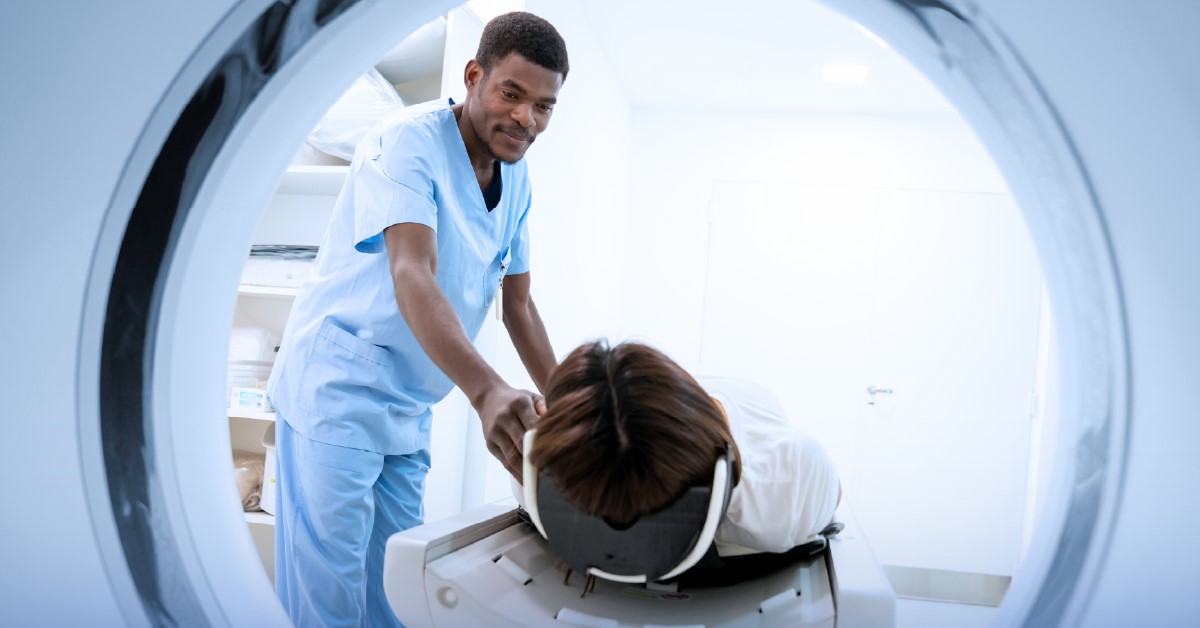Your healthcare provider has requested that you have an MRI with contrast. The addition of contrast to your MRI exam is only ordered when necessary, but the use of contrast provides highly detailed images of specific areas within your body, improving diagnostic accuracy and providing crucial, life-saving medical information.
How Does Contrast Work in an MRI?
The contrast in an MRI works by highlighting areas in your soft tissue, such as tumor growths or other developments that cannot be easily identified without contrast or on other modalities, such as CT or Mammogram. These other screening methods can’t visualize moving fluid, such as blood in your arteries, the way an MRI with contrast can. Without contrast, your arteries and veins show up on scans as plain black.
What is Gadolinium?
MRI contrast contains a chemical element called gadolinium, which reacts with bodily molecules during an MRI scan. Gadolinium is on the Periodic Table of the Elements with the atomic number of 64 and it is a silvery-white metal.
Gadolinium on its own would be harmful to humans when absorbed into their systems, however, the gadolinium used for MRI scans has gone through a process called chelation. During this process, chemical ions are used to remove its toxicity. As a result, the agent is made safe for humans while retaining its usefulness in the scanning procedure.
Hundreds of millions of doses of gadolinium-based contrast agents (GBCAs) have been given to patients throughout the world since these agents were first developed and approved for use in 1988.
How is Gadolinium Contrast Administered?
If contrast is being used in your MRI, it is usually injected intravenously before the MRI scan is performed. In certain scans, an injection may be done halfway through, so that the radiologist and your physician can compare the scans that were performed with and without the contrast, checking for any differences or noticeable features.
In patients with healthy kidney function, the gadolinium in the body will be eliminated naturally within about 24 hours after the injection. Cases of reactions are very uncommon and if they do occur, are usually mild such as headache, nausea and pain at injection site.
What is the Debate Over Gadolinium in Contrast?
Controversy surrounding gadolinium began in late 2014 when a study came out showing that the agent is deposited and retained in the brain. This, combined with a small percentage of patients who claimed their health was harmed following gadolinium exams, began the debate.
While it is already a known fact that patients with renal insufficiency cannot easily filter the gadolinium from their body, there has thus far been very little evidence showing patient safety issues in those with normal renal function.
The FDA stepped into the fray in 2017, recommending new warning labels on all GBCA packaging but also stated that there is no clinical evidence that directly links gadolinium retention to adverse health effects in patients with normal kidney function. It further concluded that the benefits of all approved GBCAs – meaning, MRI with contrast – continues to outweigh any potential risks.1
Not All GBCAs Are the Same
Structurally, gadolinium-containing contrast agents can be divided into two groups, based on the type of ligand (meaning, the way the gadolinium attaches to the molecule); linear contrast agents and macrocylic contrast agents, which are considered to be the most stable.
In one study, published in Radiology, gadolinium concentrations in animal test-subjects were lower after administration of macrocylic based contrast agents than those after administration of linear agents. Further, the elimination process of gadolinium continued continuously for a full year for macrocylic but not linear agents.2
Assurance with ClariscanTM Contrast Agent
At RadNet/Breastlink and Arizona Diagnostic Radiology, we use a gadolinium contrast produced by GE, called ClariscanTM, a macrocylic agent that has been administered in over 20 million patients worldwide, with a very low rate of adverse side-effects.
A real-world study, conducted in a clinical setting, focused on the effectiveness of ClariscanTM specifically. This study was published by the National Institutes of Health and ultimately found that ClariscanTM is safe and effective in both adults and children.3
We recognize that when you need an MRI with contrast, your only concern should be getting the answers you need to address your health matters, and not negative reactions from your contrast agent. For this reason, we use the most advanced, science-backed materials and modalities in all of our centers because your health and safety are our top priority.




Add new comment